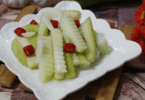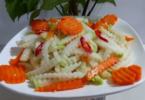Vietnamese Pickled Mustard Green Stems – A Crunchy, Tangy Taste of Vietnam
If you’re looking for something fresh, light, and full of flavor, try Vietnamese pickled mustard green stems, known as Dua Cai Ngong. This traditional dish from Vietnam is a crunchy, bitter and sour condiment that pairs perfectly with rich foods like braised pork or fried tofu. It’s made using young mustard green stems and a simple mix of vinegar, sugar, and salt. In this guide, we’ll show you the easy ingredients, the full pickling process, and how to enjoy this everyday favorite from Vietnamese food.
What is Vietnamese Pickled Mustard Green Stems?

Vietnamese Pickled Mustard Green Stems, or Dua cai ngong, is a traditional Vietnamese pickle made from the tender stems of mustard greens. The dish is created by soaking the green stems in a mixture of vinegar, sugar, salt, and sometimes garlic or chili, resulting in a light, tangy, and slightly sweet flavor. Dua cai ngong is especially popular in northern and central Vietnam, where home cooks often make it as a daily condiment to accompany rice, braised meats, or tofu dishes. Its refreshing crunch and balanced taste make it a favorite in Vietnamese homes—not just for its flavor, but also for its simplicity and health benefits.
Ingredients You’ll Need

- 300g mustard green stems (young and tender)
- 1 tablespoon salt
- 2 tablespoons white sugar
- 150ml white vinegar (or rice vinegar for a lighter flavor)
- 200ml warm water
- 1 garlic clove, thinly sliced (optional)
- 1 small red chili, sliced (optional, for a spicy kick)
The Pickling Process
Step 1: Prepare the Mustard Green Stems

- Rinse the mustard green stems thoroughly under cold water to remove any dirt.
- Trim off the tough bottom ends and cut the stems into 7–10 cm (about 3–4 inch) pieces.
- Shake off excess water and let the stems dry completely.
Step 2: Make the Pickling Brine

- In a mixing bowl, combine:
- 200ml warm water
- 2 tablespoons sugar
- 1 tablespoon salt
- 150ml white vinegar (or rice vinegar)
- Stir well until the sugar and salt dissolve completely.
- Let the brine cool to room temperature before using.
Step 3: Pack the Jar

- Place the dried mustard green stems into a clean glass jar.
- If using, add thin slices of garlic and chili for extra flavor.
- Slowly pour the cooled brine into the jar, making sure the stems are fully submerged.
- Tap the jar gently on the counter to release any air bubbles.
Step 4: Let It Pickle

- Seal the jar tightly with a clean lid.
- Leave the jar at room temperature (not in direct sunlight) for 24–48 hours.
- Taste after 1 day. If it’s tangy and crunchy, it’s ready! If you want it stronger, leave it for another day.
Step 5: Store and Serve

- Once the flavor is just right, transfer the jar to the refrigerator.
- The pickles will stay fresh and crunchy for 5–7 days.
- Always use clean utensils when serving to avoid contamination.
Common Mistakes to Avoid
– Over-pickling at room temperature
Leaving the pickles out for too long can lead to an overly sour taste and soft texture.
Solution: Pickle at room temperature for 24–48 hours only, then store in the fridge.
– Not using clean jars or utensils
Dirty jars or spoons can introduce bacteria, leading to mold or spoilage.
Solution: Always sterilize your jar and use clean, dry utensils.
– Using plastic containers
Plastic can absorb smells and may react with vinegar over time.
Solution: Use a clean glass jar with a tight lid for best results and food safety.
– Overcrowding the jar
Stuffing too many mustard green stems into one jar can prevent the brine from circulating evenly. Some parts may not pickle properly, and the texture can be inconsistent.
Solution: Leave some space at the top and make sure the brine fully covers the vegetables. If needed, use two jars instead of one.
– Not tasting the brine before pickling
Sometimes, the brine may be too sour, too sweet, or too salty — and you won’t notice until it’s too late.
Solution: Taste the brine before pouring it into the jar. Adjust the vinegar, sugar, or salt to your liking before pickling.
– Forgetting to remove air bubbles
Trapped air can cause uneven pickling or lead to early spoilage.
Solution: After packing the jar, tap it gently on the counter or use a clean spoon to press down the veggies and release trapped air.
– Leaving pickles in direct sunlight
Sunlight can cause over-fermentation or discoloration, especially if your jar is made of clear glass.
Solution: Ferment in a cool, shaded place — like a kitchen counter away from the window.
– Not monitoring the pickling time
Leaving pickles out too long at room temperature can make them mushy and overly sour.
Solution: Check your pickles after 24 hours. If they taste right, move them to the fridge immediately to slow down the process.

Conclusion
Vietnamese pickled mustard green stems (Dua Cai Ngong) are a beautiful example of how simple, fresh ingredients can turn into something bright, flavorful, and full of character. With just a few steps, you can create a crunchy, sweet-and-sour condiment that brings balance and freshness to any meal.
Ready to bring some Vietnamese flavor to your table? Grab your mustard greens, follow the simple pickling process, and enjoy your homemade dua cai ngong in just a few days. Snap a photo and share it using #VNIFood — we’d love to feature your creation!

| Prep Time | 15 minutes |
| Servings |
people
|
- 300 g mustard green stems
- 1 tablespoon Salt
- 2 tablespoons Sugar
- 150 ml white vinegar
- 200 ml warm water
- 1 clove garlic
- 1 Red Chili
Ingredients
|

|
- Prepare the Mustard Green Stems Rinse the mustard green stems thoroughly under cold water to remove any dirt. Trim off the tough bottom ends and cut the stems into 7–10 cm (about 3–4 inch) pieces. Shake off excess water and let the stems dry completely.

- Make the Pickling Brine In a mixing bowl, combine: 200ml warm water 2 tablespoons sugar 1 tablespoon salt 150ml white vinegar (or rice vinegar) Stir well until the sugar and salt dissolve completely. Let the brine cool to room temperature before using.

- Pack the Jar Place the dried mustard green stems into a clean glass jar. If using, add thin slices of garlic and chili for extra flavor. Slowly pour the cooled brine into the jar, making sure the stems are fully submerged. Tap the jar gently on the counter to release any air bubbles.

- Let It Pickle Seal the jar tightly with a clean lid. Leave the jar at room temperature (not in direct sunlight) for 24–48 hours. Taste after 1 day. If it’s tangy and crunchy, it’s ready! If you want it stronger, leave it for another day.

- Store and Serve Once the flavor is just right, transfer the jar to the refrigerator. The pickles will stay fresh and crunchy for 5–7 days. Always use clean utensils when serving to avoid contamination.








